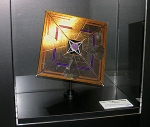Displaying items by tag: IKAROS
IKAROS
IKAROS (Interplanetary Kite-craft Accelerated by Radiation Of the Sun) is a Japan Aerospace Exploration Agency (JAXA) experimental spacecraft. The spacecraft was launched on 21 May, 2010, aboard an H-IIA rocket, together with the Akatsuki (Venus Climate Orbiter) probe and four other small spacecraft. IKAROS is the first spacecraft to successfully demonstrate solar-sail technology in interplanetary space.
On December 8, 2010, IKAROS passed by Venus at about 80,800 km distance, completing the planned mission successfully, and entered its extended operation phase.
The IKAROS probe is the world's first spacecraft to use solar sailing as the main propulsion. It plans to demonstrate four key technologies (comments in parentheses refer to figure):
- Deployment and control of a large, thin solar sail membrane (blue areas numbered 3)
- Thin-film solar cells integrated into the sail to power the payload (black rectangles numbered 4)
- Measurement of acceleration due to radiation pressure on the solar sail
- Attitude control via variable reflectance liquid crystal panels (orange rectangles numbered 2)
The mission also includes investigations of aspects of interplanetary space, such as the gamma-ray burst, solar wind and cosmic dust.
The probe's ALADDIN instrument (ALDN-S and ALDN-E) measured the variation in dust density while its Gamma-Ray Burst Polarimeter (GAP) measured the polarization of gamma-ray bursts during its six month cruise.
If successful, IKAROS is to be followed by a 50 m (160 ft) sail, intended to journey to Jupiter and theTrojan asteroids, later in the decade.


